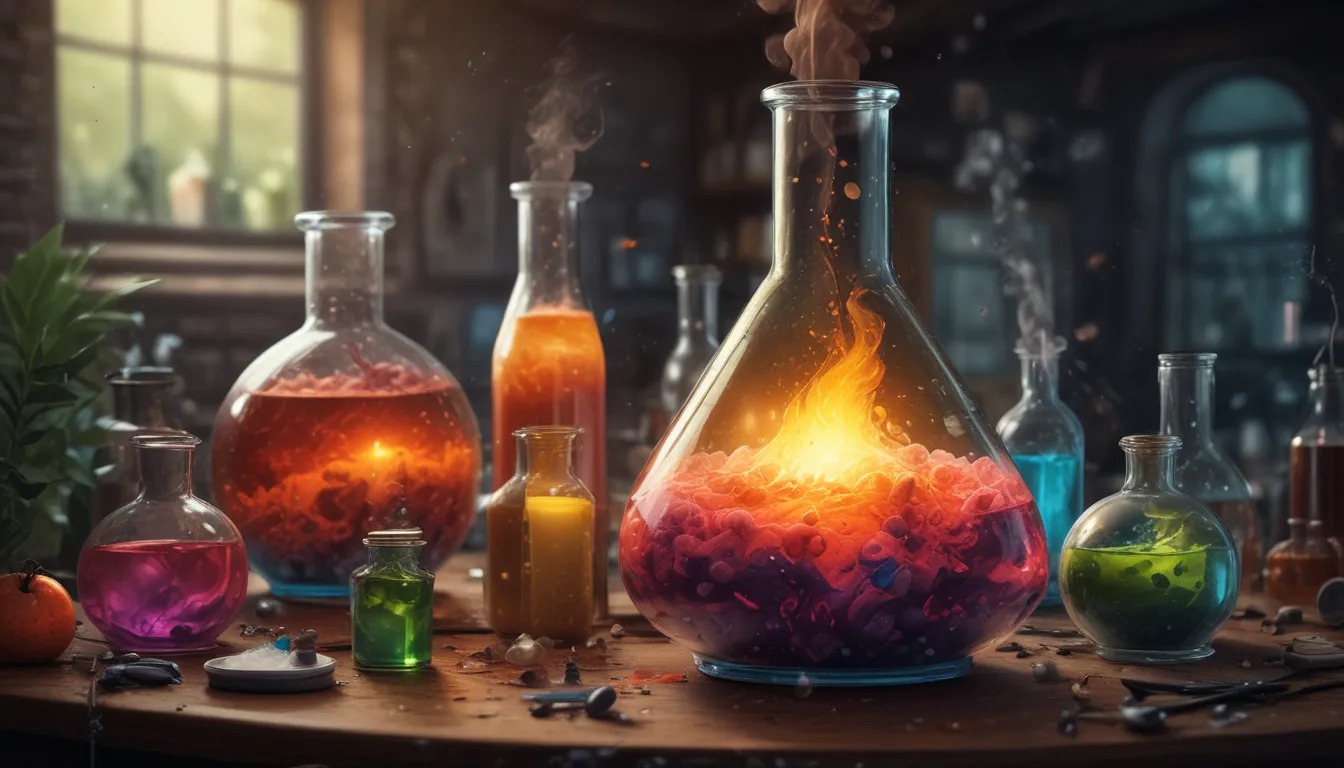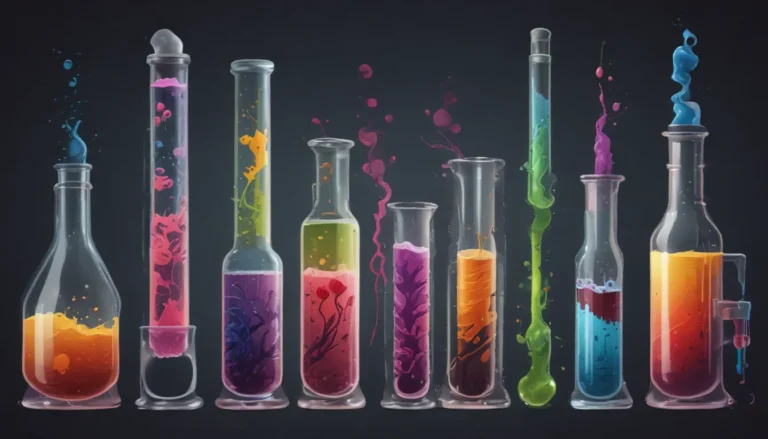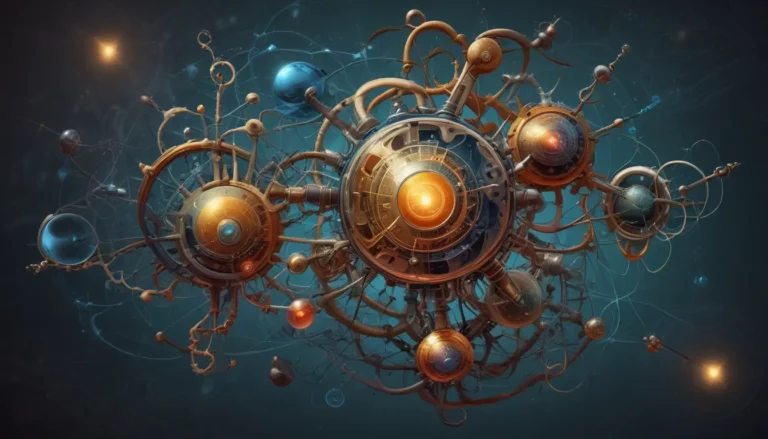A Note About Images: The images used in our articles are for illustration purposes only and may not exactly match the content. They are meant to engage readers, but the text should be relied upon for accurate information.
Have you ever marveled at the brilliance of fireworks or pondered the magical transformation of leaves during fall? The secrets behind these captivating phenomena lie in the realm of chemical changes. These changes, whether explosive or subtle, are constantly occurring around us, shaping the world we inhabit and the products we interact with daily. Chemical changes involve the intricate dance of breaking and forming bonds between atoms, giving rise to novel substances with distinct properties. Join us on a journey as we uncover 28 intriguing facts about chemical changes that will illuminate your understanding of the world!
Unveiling the Essence of Chemical Changes
Chemical changes are captivating processes that metamorphose substances into entirely new materials, each endowed with fresh properties and compositions. Unlike physical changes that merely alter the appearance or form of a substance, chemical changes work their magic at a molecular level. Here are some enthralling facts shedding light on the essence of chemical changes:
- Chemical changes involve the delicate art of breaking and forming bonds between atoms, culminating in the emergence of one or more novel substances. This fundamental process sets chemical changes apart from mere physical alterations.
- Energy plays a pivotal role in chemical changes, being either absorbed or released during the transformation. The direction of this energy shift serves as a vital indicator of a chemical reaction in progress.
The Magic of Chemical Changes in Everyday Life
Chemical changes are not restricted to laboratories but unfold all around us, often imperceptibly.
- Cooking exemplifies a quintessential form of chemical change. The application of heat instigates chemical reactions within food molecules, altering them in ways that enrich flavor, texture, and digestibility.
- Witness the ubiquitous rusting of iron, where oxygen from the air engages in a transformative dance with iron to create iron oxide. This metamorphosis not only influences the color and texture of iron but fundamentally alters its chemical composition.
- Delve into the remarkable realm of photosynthesis in plants, a natural chemical change wherein carbon dioxide and water transmute into glucose and oxygen, fueled by sunlight. This life-sustaining process generates oxygen essential for our very breath.
Deciphering the Signs of Chemical Changes
Numerous cues serve as harbingers of a chemical change unfolding. Recognizing these indicators can aid in pinpointing chemical reactions across diverse settings.
- Color alteration stands out as a conspicuous marker of a chemical change. While not all color variations denote a chemical reaction, some hint at transformative processes.
- The emergence of gas often signals a chemical change, particularly when gas is generated sans external heating. The presence of bubbles or fizz during a reaction points to gas release.
- Temperature fluctuations within a substance, devoid of external heat manipulation, hint at an exothermic or endothermic chemical reaction.
- Witness the birth of a precipitate – a solid arising from a liquid solution amid a chemical reaction. This solid entity signifies a fresh substance born from the alchemy of reaction.
The Impact of Chemical Changes on the Environment
Chemical changes wield a profound influence on our environment, yielding both positive and negative repercussions.
- Acid rain, a byproduct of chemical reactions in the atmosphere, emerges from the interplay of pollutants like sulfur dioxide and nitrogen oxides with water vapor. These reactive compounds descend as acidic rain, wreaking havoc on ecosystems.
- Embrace the virtues of biodegradation, a beneficial chemical change wherein microorganisms dismantle substances into simpler compounds, aiding in waste reduction and pollution mitigation.
- Contemplate the perils of ozone depletion, stemming from atmospheric chemical reactions that disintegrate ozone molecules, thereby diminishing Earth’s defense against harmful UV radiation.
Chemical Changes at the Heart of Industry
Industries rely heavily on chemical changes to fabricate an array of products, spanning materials to medicines.
- Embark on the journey of plastics manufacturing, governed by chemical reactions that polymerize monomers into polymers, fostering the creation of diverse plastics deployed in myriad applications.
- Traverse the realm of pharmaceuticals production, wherein chemical changes orchestrate the synthesis of therapeutic drugs fostering disease treatment and health enhancement. These reactions are meticulously controlled to yield the desired medicinal compounds.
- Venture into the intricate world of petroleum refining, a labyrinth of chemical changes that metamorphose crude oil into usable derivatives like gasoline, diesel, and jet fuel. This intricate process involves molecular breakdown and rearrangement to birth functional products.
Enchanting Chemical Reactions
Certain chemical reactions stand out for their uniqueness or dramatic impact, captivating the imagination.
- Behold the marvel of the thermite reaction, showcasing intense heat and molten iron harnessed in welding and demonstrations spotlighting the energy release inherent in chemical changes.
- Marvel at bioluminescence, a natural chemical reaction unfolding within living organisms to produce luminescence. This mesmerizing spectacle graces fireflies and deep-sea denizens, among others.
- Delve into the fascinating tapestry of the Belousov-Zhabotinsky reaction, a visually stunning chemical oscillation unfolding over hours, captivating onlookers with its kaleidoscopic color shifts engendered by the cyclic oxidation of malonic acid.
Catalysts: Pioneers of Chemical Changes
Catalysts emerge as stalwarts accelerating chemical reactions sans consumption. They play a pivotal role in both natural and industrial chemical transformations.
- Enzymes emerge as biological catalysts expediting myriad chemical reactions within living organisms, enabling life-sustaining processes to unfold at manageable rates.
- Industrial catalysts prove invaluable in expediting chemical reactions within manufacturing processes, enhancing efficiency and curbing costs. Witness their indispensable role in the synthesis of ammonia by the Haber process.
- Catalysts exhibit specificity toward certain reactions, selectively accelerating particular chemical changes while leaving others untouched. This specificity underpins the control and outcomes of intricate reactions.
Safety Amid Chemical Changes
While pivotal for myriad processes, chemical changes harbor risks when mismanaged.
- Chemical reactions may spawn toxic substances, mandating cautious handling and disposal to avert environmental harm and health hazards.
- Explosive reactions pose hazards in laboratories and industries alike. Adherence to safety protocols, encompassing appropriate containment measures and controlled conditions, proves imperative in staving off accidents.
- Engage with the rapid chemical change denominating fire, entailing oxygen-fueled combustions. Profound comprehension of the chemical essence of fire underpins effective fire prevention and safety measures.
A Glimpse into the Future of Chemical Changes
Strides in science and technology continue to enrich our comprehension of chemical changes, paving the way for novel applications and enhancements across manifold domains.
- Embrace the ethos of green chemistry, aimed at crafting chemical products and processes that curtail or eliminate hazardous substances’ usage and generation, fostering environmental sustainability.
- Immerse yourself in the realm of nanotechnology, vested in manipulating matter at atomic and molecular scales through chemical changes to engender materials boasting novel properties and functionalities.
- Embark on the frontier of synthetic biology, uniting biology and chemistry to devise and erect new biological components, devices, and systems, poised to revolutionize medicine, energy, and materials science.
- Witness the burgeoning role of artificial intelligence (AI) in forecasting chemical reaction outcomes, expediting research and development within chemistry and pharmaceutical realms.
Embracing the Enigma of Chemical Transformations
Chemical changes catalyze transformations enveloping matter, both visible and imperceivable to the unaided eye. From rust encasing an aging bicycle to the culinary alchemy of cake baking, these changes underpin comprehension of the world. They aren’t mere domain relegated to laboratory scientists; they pulsate in your kitchen, amid nature, and even within you. Grasping the foundational tenets of chemical changes transmutes mundane observations into profound insights into the natural phenomena. Bear in mind, each instance you witness a color shift, perceive heat generation or absorption, discern gas release, or annote a precipitate formation, you’re embarking on a wondrous voyage through the realm of chemical transformations. Hence, when confronted with evolving phenomena, take a pause to contemplate the chemical reactions orchestrating the symphony. It furnishes a means to forge a connection with the intricate and dynamic chemistry molding our quotidian encounters.
Frequently Asked Questions: Unveiling Clarities
-
What exactly is a chemical change?
A chemical change epitomizes a process wherein substances unite or fragment, birthed fresh substances sporting distinct properties. Analogous to baking a cake wherein the mingling and baking engender transmutation of original ingredients into something novel and delectable. -
Can you reverse a chemical change?
Reversing a chemical change embodies a daunting endeavor. Unlike physical changes amenable to reversal through tinkering with conditions like temperature or pressure, chemical changes typically mandate another chemical reaction to effect restitution. -
How can you ascertain a chemical change has transpired?
Spotting a chemical change unveils an exhilarating journey. Be on the lookout for signals like color shifts, temperature oscillations, gas generation (bubbles), or solid formation from liquid (precipitation). These indicators hint at the unfurling tapestry of a chemical change in motion. -
Why are chemical changes vital?
Chemical changes form the bedrock of myriad processes in our world, from food digestion within our bodies to fuel combustion propelling our vehicles. They underpin manufacturing, environmental stewardship, and even culinary arts. Without chemical changes, the tapestry of life would unravel. -
What delineates a chemical change from a physical change?
Akin to the contrast between changing shape and metamorphosing into something entirely novel, a physical change impacts a substance’s form sans altering its chemical identity. In contrast, a chemical change orchestrates a profound transformation, ushering in novel chemical compositions. -
Can chemical changes prove beneficial or harmful?
Chemical changes straddle both ends of the spectrum. They engender life-sustaining reactions within our bodies while furnishing the oxygen we breathe through plant metabolic shuffles. However, they can also yield pollution or hazardous substances contingent upon context and management practices. -
How do chemical changes reverberate in the environment?
Chemical changes wield a profound impact on environmental dynamics. They partake in water purification, pollution abatement, and renewable energy generation. Yet, they can also spawn ecological challenges like acid rain or ozone depletion. Striking a balance ensures a flourishing planet.
A Quest for Knowledge and Discovery
Ensconced within the realm of chemical changes lie mysteries waiting to be uncovered, knowledge beckoning to be embraced. Amidst the expanse of transformations and reactions, we glean insights into the essence of matter and the dynamic world encompassing us. Each chemical reaction, every transformative shift, epitomizes a testament to the intricate dance of atoms and bonds shaping our reality. As you navigate this enigmatic landscape, let curiosity be your guide and exploration your companion. Embrace the marvels of chemical changes, for they illuminate the path towards understanding the world in its diverse and captivating hues.





